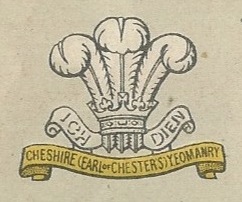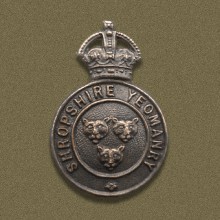
The Cheshire Yeomanry was a yeomanry regiment that can trace its history back to 1797 when Sir John Leicester of Tabley raised a county regiment of light cavalry in response to the growing fears of invasion from Napoleonic France. Its lineage is maintained by C Squadron, the Queen's Own Yeomanry.

The Shropshire Yeomanry was a yeomanry regiment of the British Army, first raised in 1795, which served as a cavalry and dismounted infantry regiment in the First World War and as a cavalry and an artillery regiment in the Second World War. It was then amalgamated with the Shropshire Royal Horse Artillery.
The 1st Mounted Division was a Yeomanry Division of the British Army active during World War I. It was formed in August 1914 for the home defence of the United Kingdom from four existing mounted brigades of the Territorial Force, each of three regiments of Yeomanry. The divisional order of battle changed often, as the 1st Line brigades left for service overseas and were replaced by 2nd Line formations. It was converted to the 1st Cyclist Division in July 1916, and was broken up in November 1916 without being involved in active service. It remained in East Anglia throughout its existence.
The Royal East Kent Yeomanry was a British Army regiment formed in 1794. It saw action in the Second Boer War and the First World War.

The Queen's Own West Kent Yeomanry was a British Army regiment formed in 1794. It served in the Second Boer War and the First World War. It amalgamated with the Royal East Kent Yeomanry to form the Kent Yeomanry in 1920.
The Welsh Horse Yeomanry was a yeomanry regiment of the British Army that served in the First World War. The regiment was raised shortly after the outbreak of the war. Initially it served in East Anglia on anti-invasion duties, before being dismounted in 1915 and sent to take part in the Gallipoli Campaign. After withdrawal to Egypt, it was amalgamated with the 1/1st Montgomeryshire Yeomanry as the 25th Battalion, Royal Welch Fusiliers and served as such throughout the rest of the war. It took part in the Sinai and Palestine Campaign in 1917 and 1918, before being transferred to the Western Front where it remained until the end of the war. The regiment formed 2nd and 3rd Lines in 1914, but these never left the United Kingdom before being disbanded in 1916 and early 1917, respectively. The 1st Line was disbanded in 1919.
The 2nd South Midland Mounted Brigade was a yeomanry brigade of the British Army, formed as part of the Territorial Force in 1908.
The London Mounted Brigade was a yeomanry brigade of the British Army, formed as part of the Territorial Force in 1908.

The 2nd Dismounted Brigade was a formation of the British Army in the First World War. It was formed in Egypt in February 1916 by absorbing the Highland Mounted Brigade and the 2nd South Western Mounted Brigade. In October it absorbed the remnants of the 1st Dismounted Brigade. The brigade served as part of the Western Frontier Force and the Suez Canal Defences.

The 3rd Dismounted Brigade was a formation of the British Army in the First World War. It was formed in Egypt in February 1916 by absorbing the Eastern Mounted Brigade and the South Eastern Mounted Brigade. The brigade served as part of the Western Frontier Force and the Suez Canal Defences.
The Eastern Mounted Brigade was a formation of the Territorial Force of the British Army, organised in 1908. After serving dismounted in the Gallipoli Campaign, it was absorbed into the 3rd Dismounted Brigade in Egypt in February 1916.
The South Eastern Mounted Brigade was a formation of the Territorial Force of the British Army, organised in 1908. After service in the Gallipoli Campaign, it was absorbed into the 3rd Dismounted Brigade in Egypt in February 1916.
The Royal 1st Devon Yeomanry was a Yeomanry regiment of the British Army. First raised in 1794, it participated in the Second Boer War and the First World War before being amalgamated with the Royal North Devon Yeomanry in 1920 to form the Royal Devon Yeomanry.
The Scottish Horse Mounted Brigade was a formation of the Territorial Force of the British Army, raised in August 1914, during the First World War. After service in the Gallipoli Campaign and in the defence of Egypt, it was absorbed into the 1st Dismounted Brigade in February 1916.
The 1st Dismounted Brigade was a formation of the British Army in World War I. It was formed in Egypt in February 1916 by absorbing the Lowland and Scottish Horse Mounted Brigades. The brigade was on Suez Canal defences attached to the 52nd (Lowland) Division and was broken up in October 1916.
The Lowland Mounted Brigade was a formation of the Territorial Force of the British Army, organised in 1908. After service in the Gallipoli Campaign, it was absorbed into the 1st Dismounted Brigade in February 1916.
The Highland Mounted Brigade was a formation of the Territorial Force of the British Army, organised in 1908. After service in the Gallipoli Campaign and in the defence of Egypt, it was absorbed into the 2nd Dismounted Brigade in February 1916.
The 17th Mounted Brigade previously known as the 2/1st Welsh Border Mounted Brigade was a 2nd Line yeomanry brigade of the British Army during the First World War. In July 1916 it was converted to a cyclist formation as 10th Cyclist Brigade and in November 1916 was redesignated as 6th Cyclist Brigade. It was still in existence, in Ireland, at the end of the war.
The 2nd South Western Mounted Brigade was a formation of the Territorial Force of the British Army, organised in 1908. After service in the Gallipoli Campaign and in the defence of Egypt, it was absorbed into the 2nd Dismounted Brigade in February 1916.
The South Wales Mounted Brigade was a formation of the Territorial Force of the British Army, organised in 1908. After home defence service, it was posted to Egypt, where it was absorbed into the 4th Dismounted Brigade in March 1916.




